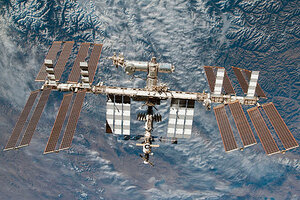Why a sixth-grader wants to brew beer in space
Michal Bodzianowski, 11, is among the winners of the National Center for Earth and Space Science Education’s six installment of its Student Spaceflight Experiments Program. Brewing beer is a test of a water purification process.

Backdropped by Earth, the International Space Station is photographed by an STS-130 crew member on space shuttle Endeavour in 2010. A Colorado student has a science experiment that could put a microbrewery in space.
REUTERS/NASA/Handout via Reuters
Mankind may be one step closer to getting extraterrestrial breweries – thanks to an eleven-year-old.
Michal Bodzianowski, 11, is among the winners of the National Center for Earth and Space Science Education’s Student Spaceflight Experiments Program, which sends student experiments to the International Space Station. His project, "What Are the Effects of Creation of Beer in Microgravity and Is It Possible?,” will be ferried upward this November as part of the program's "Mission 4."
Bodzianowski, a sixth-grader at the STEM School and Academy in Colorado’s Douglas County School District, says he wants to find out if it’s possible to brew beer in space, mixing crushed malted barley, bottled water, and yeast. It's an idea that he says could help in developing backup water supplies for future extraterrestrial colonies, since alcohol is lethal to bacteria.
Indeed, for Bodzianowski, putting microbreweries in space has little to do with furnishing Martian taps. Instead, beer could be a safe drinking water substitute in the event of an off-world disaster that contaminates the brought-along water supplies, says Bodzianowski. That’s because the fermentation process kills off water contaminants.
“For example, if a project exploded and wounded people and cut off the power, and polluted most of the water, the fermentation process could be used to make beer, which can then be used as a disinfectant and a clean drinking source,” he writes, in his project proposal.
Beer has been produced before in space, albeit in small quantities. It has also been consumed there. In 2007, news outlets reported that a team of NASA astronauts had flown while intoxicated, prompting the agency to tighten its alcohol consumption policies. The news that astronauts drank alcohol in space was little surprise to Russian cosmonauts, though. In 2010, a retired Russian astronaut speaking at Moscow's Memorial Museum of Cosmonautics told reporters that cognac and ginseng liqueur had long been space staples for Russian space-farers.
A total of 11 projects were selected for Mission 4, whittled from 744 submitted proposals. About 40 student researchers from grades 5-11 are listed as the principal investigators, co-investigators, and collaborators on the experiments.
The other winning projects include other experiments testing the effects of microgravity on bacteria. Those projects include one on bacteria decomposition, another on bacteria growth, and another on mold development on bread. Others veer toward assessing how mobile animals grow in space: how does the spotted salamander develop in microgravity? How do rainbow trout eggs hatch in orbit? Several other student projects abandon the animal kingdom for the materials sciences, investigating how metal oxidizes in saltwater in space and how silver crystal growth changes in a high-radiation environment.
The winning experiments are scheduled to launch aboard SpaceX-3 from Florida’s Cape Canaveral Air Force Station on November 11, 2013.

